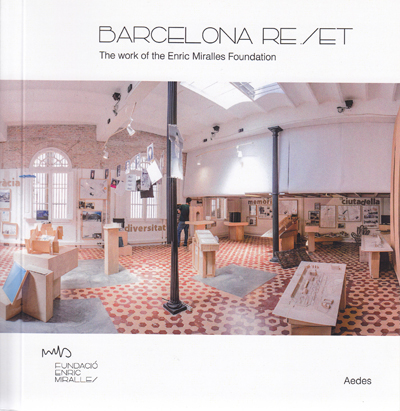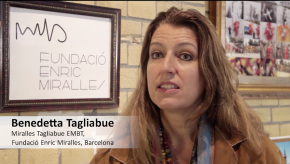Die Ausstellung zeigt Arbeiten der Enric Miralles Foundation, mit dem Fokus auf dem BCN RE.SET- Projekt, das urbane Interventionen in der Heimatstadt des im Jahr 2000 verstorbenen großen katalanischen Architekten zum Inhalt hat. Die Architektin Benedetta Tagliabue (EMBT) mit der Miralles Foundation und der Regisseur Àlex Ollé (La Fura dels Baus) haben sechs international bekannte Architekten eingeladen, temporäre urbane Installationen zu Themen zu entwickeln. Identität, Vielfalt, Freiheit, Demokratie, Erinnerung und Europa. Sie stehen in Verbindung zur 300-Jahr-Feier zur Erinnerung an die Belagerung und Eroberung von Barcelona durch die Bourbonen Armee, die von der Stadtverwaltung Barcelona organisiert und von Toni Soler kuratiert wurde.
Einige der bedeutendsten und symbolträchtigsten öffentlichen Plätze Barcelonas haben sich durch künstlerische und architektonische Installationen in diesem Jahr signifikant verwandelt. Dank der Entwürfe der Teams von Benedetta Tagliabue und Àlex Ollé (Spain), Odile Decq (Frankreich), Peter Cook (Großbritannien) & Yael Reisner (Israel), Grafton Architects (Irland), ETH Zürich & Urban-Think Tank (Schweiz/Venezuela), Anupama Kundoo (Indien/Australien) und Urbanus (China) in Verbindung mit Barcelonas führenden Schulen für Architektur und Design.
Die Enric Miralles Foundation ist ein Zentrum für experimentelle zeitgenössische Architektur basierend auf der von Miralles entwickelten Denk- und Arbeitsweise und eine Plattform für Wissensvermittlung. Die Stiftung möchte an den Menschen ebenso wie an den Architekten Enric Miralles erinnern, seinen visionären Geist lebendig halten, sowie seine experimentelle Art zu arbeiten und die Welt wahrzunehmen fortsetzen. Sie versteht sich als offener Raum in dem das geistige Erbe von Miralles zukünftige Architektengenerationen zum Experimentieren und Forschen ermutigen soll.
BCN RE.SET Installationen:
�CENTRAL INSTALLATION
Citadel
Location: Passeig dels Til·lers
Design: Benedetta Tagliabue and Àlex Ollé
With the collaboration of Institut del Teatre
The installation of the Citadel reflects both on the notion and the physical presence of the wall as a historical monument and as a present day tool in zones of conflict. A wall divides but also provides protection and rejection, love and antipathy. Sometimes we must fight in order to transform the face of the city and break down injustice. The installation has two main parts, a structure consisting of a ghostly light steel sculpture that recreates a historical wall from eighteenth century Barcelona, and a contemporary wall made of precast concrete blocks. Past and present, physical and transparent. The installation is interactive. Visitors are encouraged to paint and draw on the back of the concrete wall, creating a public mural. A variety of games can also be played on the steel structure; which inform visitors of historical events that have occurred throughout the past 300 years in Catalonia.
IDENTITY
Location: Plaça Nova
Design: URBANUS (China)
With the collaboration of LA SALLE (URL)
Placed in the ancient Barcelona aqueduct this installation is composed of 8000 identical pieces of pressed bamboo. These lightweight pieces are tied together to create a strong structure which creates a reproduction of the three arches of the Roman aqueduct on one side, and an impressive Catalan vault on the other. This urban sculpture allows the public to pass through and become involved with the space.
FREEDOM
Location: Plaça de Salvador Seguí
Design: Anupama Kundoo (India / Australia)
With the collaboration of IAAC
Knowledge provides freedom and progress; and the power of freedom is expressed through reading. This installation consists of three different trees which uproot the middle of Salvador Segui Square. The trunks and branches are made out of steel, the leaves of books, and the earth made of concrete. The public can sit beneath the permeable shadows of the trees to chat, read, and enjoy the gentle breeze created by the air passing through the leaves.
EUROPE
Location: Plaça del Mar
Design: ETH Zürich & Urban-Think Tank (Switzerland/Venezuela)
With the collaboration of ESARQ (UIC)
The concept of the installation of Europe is based on the children’s game hopscotch, a game often played throughout Europe. This steel structure covered by recycled fishing
nets and sails is a recreation of old self-constructed beach stands. Visitors are encouraged to use the swing and play with the giant hopscotch pattern which is painted on the ground. This installation embraces different cultures as it creates a space for the public to celebrate difference together.
DIVERSITY
Location: Plaça dels Àngels
Design: Studio Odile Decq (France)
With the collaboration of Recetas Colectivas
The city of Barcelona has a large amount of diversity which is expressed through the installation of a canopy of 300 black t-shirts with 300 different portraits. This canopy of hanging t-shirts with white faces made of people that have passed through the space provides shadow and makes a tribute to the mediterranean tradition of hanging wet clothes to dry in patios and facades.
DEMOCRACY
Location: Plaça de la Mercè
Design: Peter Cook (United Kingdom) & Yael Reisner (Israel)
With the collaboration of Straddle3
“Walking down the aisle” is a tradition often seen in the ceremony of religious marriage and civil marriage. At one end of the courtyard stands the Civil Reigstrar´s office, and at other one of the main churches of Barcelona, the installation is located in the middle, filling the plaza which separates the two. Suspended above the plaza is a huge inflatable human rights logo which provides shade for a ceremonial platform decorated with white flowers for newly weds. The installation was opened to the public with the beautiful silver (25th) wedding anniversary of the designers of this exhibition, architects Yael Reisner with Peter Cook.
MEMORY
Location: Arc de Triomf
Design: Grafton Architects (Ireland)
With the collaboration of ELISAVA (UPF)
A 3 dimensional kite that has escaped from a nearby Park and landed next to the Arc de Triomf where it provides a domestic space. This installation refers to the concept of memory as a sum of individual and private memories and stories. It consists of a 9 meter high structure with pictures taken by the photographer Joan Branguli of Barcelona at the beginning of the twentieth century. A colourful wooden platform containing a map of the old topography and rivers of the city acts as the base for this structure. Visitors are able to see themselves in the mirror, casting images of the present under views from the past. Lastly, 7 clay models contain different dwelling typologies from the pre-roman era to the XXth century and refer to the memory of domestic architecture.
BCN RE.SET and recycling
The interventions are noted for their attention to issues relating to recycling.
The architect Santiago Cirugeda will recover all materials used for the construction
of these installations and reuse them for different social projects in Catalonia.
Link:
www.fundacioenricmiralles.com
Katalog
Zur Ausstellung ist ein Aedes Katalog erschienen.
Mit Texten von Benedetta Tagliabue, Toni Soler und Àlex Ollé
englisch
Preis € 10,-

Sponsoren
Fundació Enric Miralles, Lamp Lighting, Institut Français, Zumtobel, Schindler, PORT Technology, AXOR, carpetconcept





